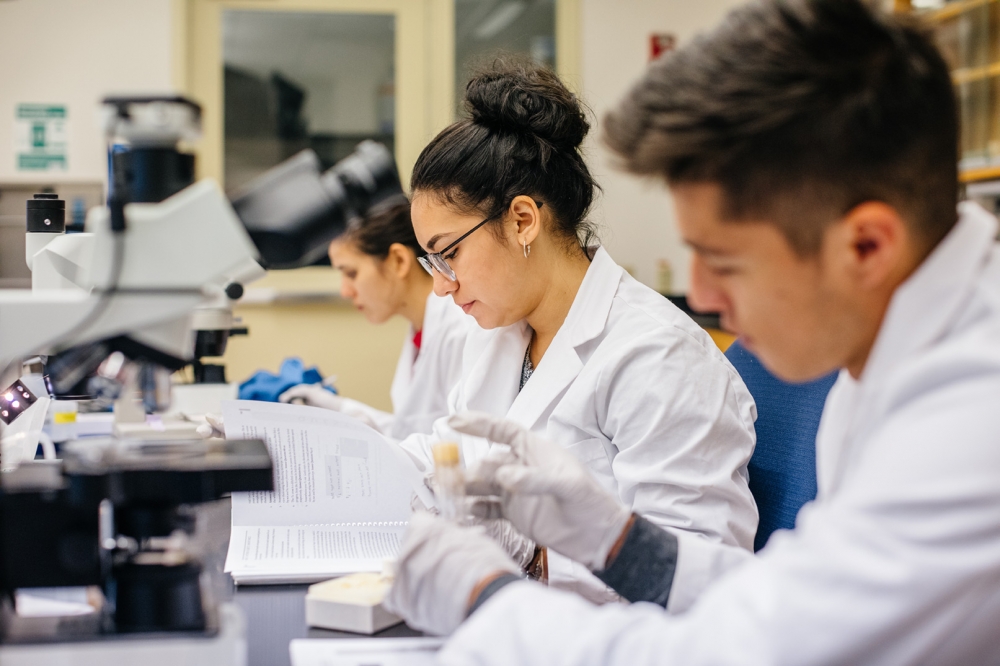
‘A Sense of Belonging’
Aiming to fortify and grow the STEM talent pipeline at Hispanic-serving institutions, UC Santa Barbara has embarked on a collaborative grant project funded by the National Science Foundation.
The NSF INCLUDES Planning Grant was awarded to the Hispanic Association of Colleges and Universities (HACU), which will team with experts from both UC Santa Barbara and the University of Arizona, also an HSI, in an effort to bolster pathways to STEM graduate education for Latinx students.
“Ours will be the first coordinated national effort to bring all of these organizations and sectors together to create a systematic plan to increase diversity and inclusion in STEM graduate programs at HSIs,” said Barbara Endemaño Walker, director of research development and the special assistant to the executive vice chancellor for diversity initiatives at UCSB. She is a co-PI on the project.
“While HSIs have been successful at enrolling and graduating undergraduate students in STEM disciplines, these students enter graduate school programs at much lower rates,” Walker explained. “In recent years there has been an increasing number of Carnegie ‘R-1’ institutions becoming HSIs, and HACU identified an opportunity to partner with two of them — UCSB and Arizona — to tackle this problem.”
Already, Walker said, there are individual HSIs, national organizations such as the Council of Graduate Schools, and corporate and industry leaders who are invested in — and conducting initiatives related to — this challenge of broadening participation in the STEM workforce and STEM professoriate. (UCSB’s current AGEP grant is one example.)
This new grant will serve to develop a cohesive team and national network to design an integrated set of national programs meant to eventually be funded with a larger NSF grant and private sources. Over the course of three planned meetings, the group will prioritize best practices that can be scaled nationwide in areas such as graduate student mentoring and leadership development; professional development for graduate students around inclusive pedagogies and research collaboration; and bridge and pipeline programs to both Latinx STEM Ph.D. attainment and the STEM workforce. They also expect to identify lead institutions to eventually serve as the regional hubs for these initiatives.
“Research has found that students of color feel isolated within STEM classrooms,” said Dolores Inés Casillas, an associate professor of Chicana and Chicano studies at UCSB and director of the Chicano Studies Institute. “The collective goal for all HSIs is to foster a sense of belonging for STEM students of color, in hopes of seeing that translate into academic achievement and degree attainment. This grant proves that it will take a village to make a substantial gain in STEM graduate degree attainment. Together with fellow HSIs as well as two-year institutions, we hope to make a substantial impact on our current rates of Latinx students and students of color within STEM.”
To that end, Casillas explained, the hope also is to ultimately establish an HSI center that would serve as a training ground for students of color in STEM and to strengthen STEM pathways for transfer students, first-generation students, and/or Latinx students and other students of color.
“We are incredibly fortunate to have an administration that has long understood our HSI status as a strength,” she said. “With our campus leadership, we are an ideal site to lead this charge. Research has demonstrated that it’s not just about pitching STEM as an academic field but by stressing how STEM topics are central to communities of color. It’s just as important to foster culturally-relevant STEM identities and experiences.”
Casillas, Walker and Carlos Nash, director of diversity programs in UCSB’s Graduate Division, are collaborating with Pamela Jennings at UC Office of the President in their effort to help HACU map out this new national agenda. The UC has more top-tier research campuses designated as HSIs than any other university system in the country; UC Santa Barbara was among the first to be so recognized.
“As a designated Hispanic-serving institution, it is critical that we mobilize to increase the representation of Latinx graduate students and faculty in STEM,” said Belinda Robnett, UCSB’s vice chancellor for diversity, equity, and inclusion, and a professor of sociology. “The representation of Latinx faculty and other historically oppressed racial-ethnic minority groups is woefully small in STEM. In addition to bringing diverse perspectives to STEM, our underrepresented students deserve to see professors in the field that look like themselves. We need to foster an environment where Latinx students experience a sense of belonging in STEM.
“My hope is that this grant will facilitate the institutionalization of best practices and create a STEM environment in support of our Latinx faculty and students,” she added. “Ultimately, these efforts should serve to attract, increase and sustain Latinx faculty in STEM.”



